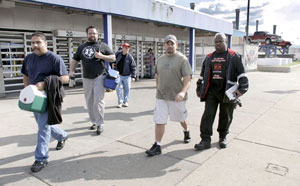(lead article)
Industrial slowdown yields cutbacks, layoffs
Cities, states plan education, health-care cuts

|
|
Getty Images/Bill Pugliano
|
|
Workers leave Chrysler assembly plant at end of their shift October 17 in Warren, Michigan. Auto workers are among many that will be laid off by bosses in coming months.
|
BY BRIAN WILLIAMS
As the contraction in capitalist industrial production continues to increase, federal and local governments are planning cutbacks in vital social services. Local governments and bosses are already eliminating jobs while Washington is printing billions of dollars in an attempt to thaw the credit freeze.
The U.S. economy has been in recession since December 2007, according to the National Bureau of Economic Research—longer than the average length for recessions since World War II.
The U.S. government announced a new $800 billion bailout program November 25 in hopes of pumping up the country’s faltering financial system. This move, one of a number of financial outlays by Washington over the past several months that total trillions of dollars, is the U.S. rulers’ response to the deepest worldwide capitalist economic crisis seen since the 1930s—with its unfolding social catastrophe for working people.
As the auto barons headed back to Washington December 2 pleading for a $34 billion bailout for General Motors, Chrysler, and Ford, United Auto Workers (UAW) president Ronald Gettelfinger signaled the union officialdom’s willingness to reopen contracts. He said the union would consider delaying payments to a new retiree health-care fund and suspending its jobs bank, which requires the companies to pay wages to laid-off workers, reported the New York Times
With 1.2 million jobs already slashed by the bosses so far this year, November is expected to show a decline of another 350,000 jobs, reports MarketWatch. The credit crunch has led to declining sales of municipal bonds—down 9.1 percent this year—which cities and states depend upon to finance their operations. As a result new taxes and deep cuts in social services are being prepared in many cities aimed at qualitatively driving down workers’ standard of living.
At the end of November New York governor David Paterson told school board presidents that deep cuts in funds for education must be implemented to make up for the state’s budget deficit of $1.5 billion this year and $12.5 billion next year.
A new federal rule announced at the end of November boosts payments that working people on Medicaid will have to pay for visits to doctors, hospital care, and prescription drugs. “Medicaid recipients will pay more than $1.3 billion in co-payments over five years and the federal government will save $1.4 billion, while states will save $1.1 billion,” said a November 27 New York Times article. “The savings would result not only from the collection of co-payments, but also from reduced use of services.”
The number of workers on food stamps is about to exceed 30 million, an all-time high. Official government statistics say that 11.9 million people went hungry in the United States for some part of last year. This included nearly 700,000 children.
According to a study by the Center on Budget and Policy Priorities, the deepening recession could push another 10 million people below the federal government’s official poverty level. In 2007, the U.S. Census Bureau reported that 37.3 million people, or 12.5 percent of the population, were already living in poverty.
$800 billion bailout package
The government’s $800 billion bailout package includes $200 billion to buy up repackaged securities backed by auto loans, student loans, credit card lending, and small-business loans. Officials hope to make credit more available to working people, those operating small businesses, and others.
The market for lending funds for these securities “essentially came to a halt in October,” stated U.S. treasury secretary Henry Paulson, after generating $240 billion in 2007.
The new pump-priming fund “underscored the severity of the credit crisis and raised concerns among some analysts that the Fed might be taking too much risk—and printing too much money—in response,” stated the November 26 Financial Times.
“Recent events showcase policymakers as bumblers or quick-footed financial firefighters,” commented Investor’s Business Daily, expressing unease that massive federal outlays are failing to staunch the economic crisis.
Over the past year, the U.S. government has taken on about $7.8 trillion in direct and indirect financial obligations. This is equal to about half the size of the nation’s entire economy and way above the $700 billion bank bailout plan Congress authorized in October. About $1.4 trillion has already been spent in loans, infusions to banks, and bailing out companies like American International Group. Additional trillions are for government guarantees on mortgages, bank deposits, commercial loans, and money market funds.
Meanwhile, the U.S. gross domestic product (GDP) shrank at an annual rate of 0.5 percent in the third-quarter. Projections are for a much steeper drop in this year’s last quarter, with Business Week estimating a 4 percent decline.
Related articles:
Sweden: financial crisis marks sharp layoff rise
| 


